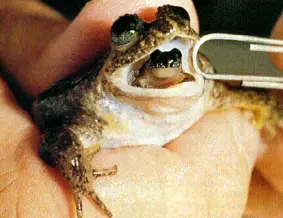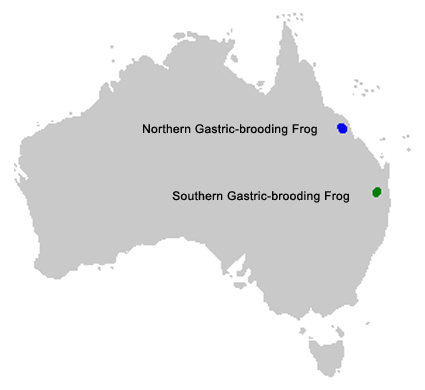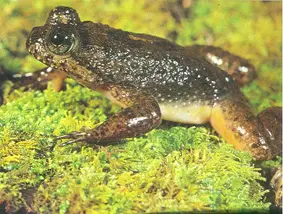The Gastric brooding frog or Platypus frogs were a genus of ground-dwelling frogs native to Queensland in eastern Australia. The genus consisted of only two species, both of which became extinct in the mid 1980s. The genus was unique because it contained the only two known frog species that incubated the young frogs in the stomach of the mother.  Strange Reproduction
Strange Reproduction
It is assumed that the Gastric brooding frog female swallowed the eggs after they had been fertilized and the tadpoles developed in female’s stomach (gastric-brooding). The production of hydrochloric acid (digestive fluids) in the stomach of the female is stopped by the hormones produced by the young. The female’s entire digestive system shuts down, which prevents the digestion of the young. After 6-7 weeks the females give birth to up to 25 young, birth is accomplished by the female widely opening her mouth and dilating her gullet (oesophagus). The young are propelled from the stomach to the mouth, and then hop away. They emerge from the female’s mouth as fully former frogs and after 4 days the digestive tract of the female returns to normal and she recommences feeding.
Southern Gastric brooding Frog (Rheobatrachus silus)
The Southern Gastric brooding Frog (Rheobatrachus silus) was discovered in 1972 and described in 1973, however, there is some suggesting that the species was discovered in 1914 (from the Blackall Range).
Rheobatrachus silus was restricted to the Blackall Range and Conondale Ranges in southeast Queensland, north of Brisbane, between elevations of 350 m and 800 m (1100 and 2600 feet) above sea level. The areas of rainforest, wet sclerophyll forest and riverine gallery open forest that it inhabited was limited to less than 1,400 km² (540 mi²). They were recorded in streams in the catchments of the Mary, Stanley and Mooloolah Rivers. Depending on the source, the last specimen seen in the wild was in 1979 in the Conondale Range, or in 1981 in the Blackall Ranges. The last captive specimen died in 1983. This species is now believed to be extinct.

Northern Gastric brooding Frog (Rheobatrachus vitellinus
The Northern Gastric brooding Frog (Rheobatrachus vitellinus) was discovered and described in 1984. It was restricted to the rainforest areas of the Clarke Range in Eungella National Park in central eastern Queensland. This species, too, was confined to a small area — less than 500 km² (200 mi²), between 400 and 1000 metres (1000 and 3000 feet) in altitude. Only a year after its discovery, it was never seen again despite extensive efforts to locate it. This species is considered to be extinct.  Cause of Extinction
Cause of Extinction
Populations of Southern Gastric-brooding Frogs were present in logged catchments between 1972 and 1979. The effect of logging activities upon Southern Gastric-brooding Frogs was not investigated but the species did continue to inhabit streams in the logged catchments. The habitat that the Southern Gastric-brooding Frog once inhabited is now threatened by feral pigs, the invasion of weeds, altered flow and water quality problems due to upstream disturbances. Despite intensive searching, the species has not been located since 1979 or 1981 (depending on the source).
The Eungella National Park, where the Northern Gastric-brooding Frog was once found, was under threat from bushfires and weed invasion. Continual fires may have destroyed or fragmented sections of the forest. The outskirts of the park are still subject to weed invasion and the chytrid fungus has been located within several rainforest creeks within the park. It was thought that the declines of the Northern Gastric-brooding Frog during 1984 and 1985 were possibly normal population fluctuations. Despite continued efforts to locate the Northern Gastric-brooding Frog it has not been found. The last reported wild specimen was seen in 1985.
The cause for the gastric-brooding frogs’ extinction is unknown but habitat loss/degradation, pollution, pathogens, and parasites plus over collecting may have all contributed. A direct threat to the habitats through human activities was not clearly apparent and the amphibian chytrid fungus is one causal suspect in the decline of these species. The chytrid fungus is the leading suspect in the extinction of almost two-thirds of the 110 knownHarlequin frog species. Other factors possibly contributing to frog declines include global changes to air and water quality, and climate change.
Scientists often refer to the worldwide disappearance of frogs, as the “canary in the coal mine”. Many scientists now say the decline in frogs is far worse than previously believed. According to a three year study by wildlife specialists, one third of the world’s 5,743 known amphibian species are threatened with extinction. Some like the Gastric Brooding frogs andGolden Toad have already disappeared.
|
Other Species Impacted Upon by Climate Change
Quiver Tree |
